

Seth. Seth (Hebrew: שֵׁתֿ, Standard Šet, Tiberian Šēṯ; Arabic: شيث Shith or Shiyth; "placed; appointed"), in Judaism, Christianity and Islam, was the third son of Adam and Eve and brother of Cain and Abel, who were the only other of their children mentioned by name.
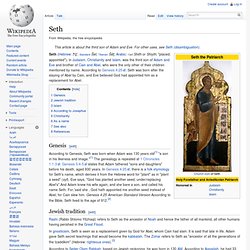
According to Genesis 4:25, Seth was born after the slaying of Abel by Cain, and Eve believed God had appointed him as a replacement for Abel. Genesis[edit] According to Genesis, Seth was born when Adam was 130 years old[1] "a son in his likeness and image. "[1] The genealogy is repeated at 1 Chronicles 1:1-3. Jewish tradition[edit] Rashi (Rabbi Shlomo Yitzhaqi) refers to Seth as the ancestor of Noah and hence the father of all mankind, all other humans having perished in the Great Flood. In gnosticism, Seth is seen as a replacement given by God for Abel, whom Cain had slain.
Angel. An angel (from the Greek ἄγγελος - ángelos[1]) is a supernatural being or spirit, often depicted in humanoid form with feathered wings on their backs and halos around their heads, found in various religions and mythologies.
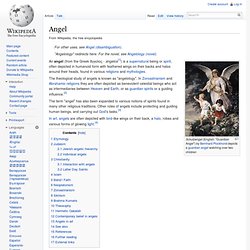
The theological study of angels is known as "angelology". In Zoroastrianism and Abrahamic religions they are often depicted as benevolent celestial beings who act as intermediaries between Heaven and Earth, or as guardian spirits or a guiding influence.[2] The term "angel" has also been expanded to various notions of spirits found in many other religious traditions.
Other roles of angels include protecting and guiding human beings, and carrying out God's tasks.[3] Etymology[edit] Archangel. An archangel /ˌɑrkˈeɪndʒəl/ is an angel of high rank.

Beings similar to archangels are found in a number of religious traditions; but the word "archangel" itself is usually associated with the Abrahamic religions of Judaism, Christianity, and Islam. Cherub. Virgin and child with cherubim A cherub (/ˈtʃɛrəb/;[1] also pl. cherubim; Hebrew כְּרוּב, pl.
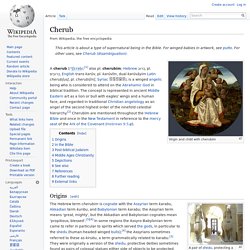
כְּרוּבִים, English trans kərūv, pl. kərūvîm, dual kərūvāyim Latin cherub[us], pl. cherubi[m], Syriac ܟܪܘܒܐ), is a winged angelic being who is considered to attend on the Abrahamic God in biblical tradition. Seraph. A seraph (/ˈsɛr.əf/; pl. seraphs or seraphim /ˈsɛr.ə.fɪm/; Hebrew: שְׂרָפִים śərāfîm, singular שָׂרָף śārāf; Latin: seraphi[m], singular seraph[us]; Greek: σεραφείμ) is a type of celestial or heavenly being in the Abrahamic religions.
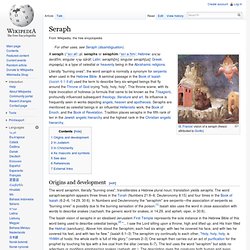
Origins and development[edit] The word seraphim, literally "burning ones", transliterates a Hebrew plural noun; translation yields seraphs. Watcher (angel) Watching angel on the spire of St Michael's church, Clifton Hampden, Oxfordshire, England In the Book of Daniel 4:13, 17, 23[4] there are three references to the class of "watcher, holy one" (watcher, Aramaic `iyr; holy one, Aramaic qaddiysh).
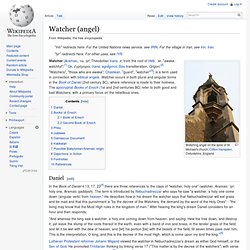
The term is introduced by Nebuchadnezzar who says he saw "a watcher, a holy one come down (singular verb) from heaven. " He describes how in his dream the watcher says that Nebuchadnezzar will eat grass and be mad and that this punishment is "by the decree of the Watchers, the demand by the word of the Holy Ones" - "the living may know that the Most High rules in the kingdom of men.
" After hearing the king's dream Daniel considers for an hour and then responds: Septuagint. The Septuagint /ˈsɛptjuːəˌdʒɪnt/, /ˈsɛptuːəˌdʒɪnt/, /ˌsɛpˈtuːədʒɪnt/, /ˈsɛptʃuːəˌdʒɪnt/, from the Latin word septuaginta (meaning seventy), is a translation of the Hebrew Bible and some related texts into Koine Greek.
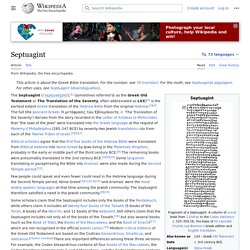
The title and its Roman numeral acronym LXX refer to the legendary seventy Jewish scholars who completed the translation as early as the late 2nd century BCE. As the primary Greek translation of the Old Testament, it is also called the Greek Old Testament (Ἡ μετάφρασις τῶν Ἑβδομήκοντα). This translation is quoted in the New Testament,[1] particularly in the Pauline epistles,[2] and also by the Apostolic Fathers and later Greek Church Fathers. The Septuagint should not be confused with the seven or more other Greek versions of the Old Testament, most of which did not survive except as fragments (some parts of these being known from Origen's Hexapla, a comparison of six translations in adjacent columns, now almost wholly lost).
Name[edit] [7] or G.
Luther Bible. The Luther Bible is a German language Bible translation from Hebrew and ancient Greek by Martin Luther, of which the New Testament was published in 1522 and the complete Bible, containing the Old and New Testaments and Apocrypha, in 1534.

The project absorbed Luther's later years.[4] The new translation was widely disseminated thanks to the printing press,[5][page needed] and it became a force in shaping the modern High German language. Luther's New Testament translation[edit] Gutenberg Bible. The Gutenberg Bible (also known as the 42-line Bible, the Mazarin Bible or the B42) was the first major book printed in the West using movable type.
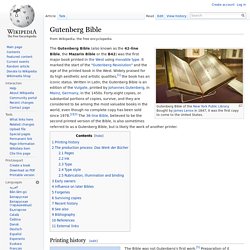
It marked the start of the "Gutenberg Revolution" and the age of the printed book in the West. Widely praised for its high aesthetic and artistic qualities,[1] the book has an iconic status. Young's Literal Translation (YLT Bible) - Version Information - BibleGateway.com. Version » Young's Literal Translation Go to: Version Information | Copyright Information| Bible-Book List Version Information The Bible text designated YLT is from the 1898 Young's Literal Translation by Robert Young who also compiled Young's Analytical Concordance.

This is an extremely literal translation that attempts to preserve the tense and word usage as found in the original Greek and Hebrew writings. The text was scanned from a reprint of the 1898 edition as published by Baker Book House, Grand Rapids Michigan. Copyright Information No copyright information available. Bible-Book List. Biblical literalism. Biblical literalism (also called Biblicism or Biblical fundamentalism) is the interpretation or translation of the explicit and primary sense of words in the Bible.[1][2] A literal Biblical interpretation is associated with the fundamentalist and evangelical hermeneutical approach to scripture—the historical-grammatical method—and is used extensively by fundamentalist Christians,[3] in contrast to the historical-critical method of liberal Christians. The essence of this approach focuses upon the author's intent as the primary meaning of the text.[4] Literal interpretation does place emphasis upon the referential aspect of the words or terms in the text.
It does not, however, mean a complete denial of literary aspects, genre, or figures of speech within the text (e.g., parable, allegory, simile, or metaphor).[5] Also literalism does not necessarily lead to total and complete agreement upon one single interpretation for any given passage. Background[edit] Book of Ezekiel. The Book of Ezekiel is the third of the Major Prophets in the Tanakh and one of the major prophetic books in the Old Testament, following the books of Isaiah and Jeremiah.
According to the book itself, it records seven visions of the prophet Ezekiel, exiled in Babylon, during the 22 years from 593 to 571 BC. The visions, and the book, are structured around three themes: (1) judgment on Israel (chapters 1–24); (2) judgment on the nations (chapters 25–32); (3) and future blessings for Israel (chapters 33–48). Structure[edit] Ezekiel has the broad three-fold structure found in a number of the prophetic books: oracles of woe against the prophet's own people, followed by oracles against Israel's neighbours, ending in prophecies of hope and salvation: Oracles against Judah and Jerusalem, chapters 1–24Oracles against the foreign nations, chapters 25–32Prophecies of hope and salvation, chapters 33–48.
Books of Kings. Contents[edit] Solomon. According to the Talmud, Solomon is one of the 48 prophets.[4] In the Qur'an, he is considered a major prophet, and Muslims generally refer to him by the Arabic variant Sulayman, son of David. Biblical account[edit] Succession[edit] Cornelis de Vos, The Anointing of Solomon . According to 1 Kings 1:39, Solomon was anointed by Zadok. According to the biblical First Book of Kings, when David was old, "he could not get warm Adonijah asked to marry Abishag the Shunammite, but Solomon disallowed that, although Bathsheba now pleaded on Adonijah's behalf. Solomon's Temple. Because of the religious sensitivities involved, and the politically volatile situation in Jerusalem, only limited archaeological surveys of the Temple Mount have been conducted. No excavations have been allowed on the Temple Mount during modern times.
An Ivory pomegranate mentions priests in the house of YHWH, and an inscription recording the Temple's restoration under Jehoash have appeared on the antiquities market, but the authenticity of both has been challenged and they remain the subject of controversy. The Temple according to the Bible[edit] In an artistic representation, King Solomon dedicates the Temple at Jerusalem (painting by James Tissot or follower, c. 1896–1902) Second Temple. The Second Temple was an important Jewish Holy Temple (Hebrew: בֵּית־הַמִּקְדָּשׁ הַשֵּׁנִי: Bet HaMikdash HaSheni; Arabic: بيت القدس: Beit al-Quds) which stood on the Temple Mount in Jerusalem during the Second Temple period, between 516 BCE and 70 CE.